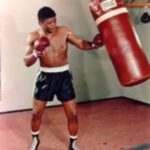On October 2, 1980, Muhammad Ali, one of the most popular and charismatic athletes the sporting world has ever known, failed miserably in his quest to regain the heavyweight boxing championship for an unprecedented fourth time, taking a one-sided beating in a fight that many believe contributed to Ali’s eventual development of Parkinson’s Syndrome. Showing a surprising lack of vigor and energy, and being painfully slow of foot and reflex, Ali, at the age of 38, and after a two-year retirement from boxing that included very little training but an awful lot of eating, was a shadow of his former greatness, being thoroughly outclassed and trounced by the very capable champion, Larry Holmes.
In a fight that many people feel never should have been allowed to happen in the first place, the great Muhammad Ali, the same man who shocked George Foreman and the world in Zaire and stopped Joe Frazier in a brutal yet beautiful fight in Manila, was left battered and bruised at the end of ten one-sided rounds, at which point his long-time corner man and trainer, Angelo Dundee, put an end to the carnage and refused to let his fighter proceed with the night’s assignment. “Thank you,” Muhammad Ali whispered to Dundee through swollen and bruised lips. Ali’s pride and courage, so spectacularly displayed throughout his long and storied career, was still very much intact; if it had not been for Dundee’s merciful halting of the night’s proceedings, Ali would have no doubt continued to fight. He was a champion after all, and champion’s fight! But the questions still remain to this day as to why Ali was allowed to fight in the first place. The trouble signs were plainly evident well before Ali’s challenge of Holmes.
Muhammad Ali’s voice and speech patterns had clearly changed over the years, and prior to his fight against Holmes, there were countless people who made a point of Ali’s frequent slurring of his words. He was no longer the rapid-talking, verbose Ali of old; his voice was thicker and heavier, and there were certain words that Ali seemed to have trouble pronouncing. Prior to the Holmes fight, the Nevada boxing officials mandated that Ali be given the go ahead to fight only after he was deemed physically fit by his doctors. In response to the public attention and questions surrounding his health, and to confront the rumors swirling around about possible brain damage, Ali checked himself in to the world renowned Mayo Clinic for a battery of tests. There, over the course of several days, Ali was submitted to a variety of neurological and other tests. And the results seemed to cause more questions than they answered.
Ali’s basic neurological functioning was found to be slightly impaired. On basic finger-to-nose testing, in the doctor’s own words, “there was a slight degree of missing the target!” On basic motor skills functioning, it was found that “Ali did not quite hop with the agility” that would be expected for a man of his age and overall physical conditioning. In addition, there was a pronounced thickening of his speech, which seemed to be exacerbated by fatigue, and Ali admitted to having occasional “tingling and numbness” of the hands and feet. And on top of everything else, an MRI brain scan found that Ali had a small hole in the membrane separating the two sides of his brain; a condition that could be exacerbated by being punched in the head repeatedly! Yet, after Ali completed all of his physical and neurological testing at the Mayo Clinic, he was remarkably given an overall clean bill of health. And he was cleared to engage in a heavyweight championship fight with Larry Holmes, despite his thickening speech, his restricted agility, his flunking of his finger-to-nose testing, and in spite of a hole in his brain membrane.
And physically Ali looked the picture of health. He had lost all of the excess weight that he gained over the course of his retirement, and with a little dye to cover his gray hair, Ali looked like the Ali of old. But in truth, Ali was nothing but an old, sick Ali. He had nothing to offer. Nothing! It was clear from the first round on against Larry Holmes that the fight would be no contest. And it wasn’t! Ali didn’t win a single round. And not long after the fight, Ali’s “condition” seemed to deteriorate. He started developing an odd shuffling type of a walk; a slight tremor became noticeable in his hands, and a new battery of physical and neurological tests followed. And by 1984, Muhammad Ali was diagnosed with Parkinson’s Syndrome, a collection of neurologically-based symptoms that affect speech and motor skills. And his many doctors and specialists believe that Muhammad Ali’s Parkinson’s Syndrome is the result of head trauma; years of being punched in the head, especially in his later years, having irreversibly damaged Ali’s brain stem. And many people have speculated that the brutal beating that Ali suffered in the Larry Holmes bout, a fight in which he absorbed numerous powerful shots to the head, precipitated his eventual neurological and physical decline.




